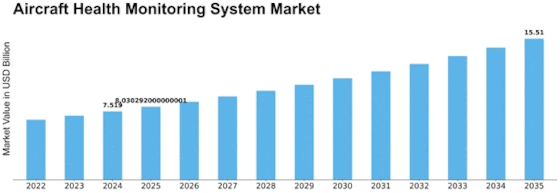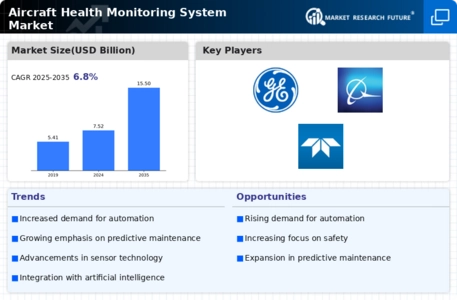Aircraft Health Monitoring System Size
Aircraft Health Monitoring System Market Growth Projections and Opportunities
The aircraft health monitoring system (AHMS) market is influenced by a multitude of factors that collectively shape its landscape and growth potential. Firstly, the increasing emphasis on aircraft safety and maintenance efficiency drives the demand for AHMS solutions. With the aviation industry's relentless focus on passenger safety and operational reliability, there is a growing need for advanced monitoring systems that can detect potential faults and issues in aircraft systems proactively. AHMS solutions offer real-time monitoring, predictive analytics, and condition-based maintenance capabilities, enabling operators to identify and address maintenance issues before they escalate into safety risks or operational disruptions.
Secondly, technological advancements and innovation play a pivotal role in driving the growth of the AHMS market. As sensor technology, data analytics, and connectivity capabilities continue to evolve, AHMS solutions become more sophisticated and capable of monitoring a wide range of aircraft systems and components. Advanced sensors, such as strain gauges, accelerometers, and temperature sensors, provide real-time data on the health and performance of critical aircraft systems, enabling proactive maintenance and optimization of operational efficiency.
Furthermore, regulatory mandates and industry standards significantly influence the adoption of AHMS solutions in the aviation sector. Aviation authorities, such as the Federal Aviation Administration (FAA) and the European Aviation Safety Agency (EASA), impose regulations and guidelines on aircraft maintenance and safety practices, driving the adoption of AHMS technologies to ensure compliance with airworthiness requirements. Additionally, industry standards bodies, such as the Society of Automotive Engineers (SAE) and the International Air Transport Association (IATA), establish guidelines and best practices for AHMS implementation, promoting interoperability and standardization in the market.
Moreover, market trends in the commercial aviation sector impact the demand for AHMS solutions. With the growing complexity and sophistication of modern aircraft systems, operators seek comprehensive AHMS platforms that can monitor multiple systems and components simultaneously. AHMS solutions offer operators greater visibility into the health and performance of critical aircraft systems, enabling proactive maintenance planning, improved operational efficiency, and enhanced safety margins. Additionally, the rise of predictive maintenance models and data-driven decision-making processes further drives the adoption of AHMS solutions, as operators seek to minimize downtime, reduce maintenance costs, and optimize fleet performance.
Additionally, cost considerations and economic factors influence the adoption of AHMS solutions in the aviation industry. While AHMS technologies offer significant benefits in terms of safety, efficiency, and reliability, they also entail upfront investment costs for equipment, installation, and training. Aircraft operators evaluate the total cost of ownership and return on investment when considering AHMS implementation, weighing the benefits of enhanced safety and operational efficiency against the initial capital outlay and ongoing maintenance expenses.
Furthermore, market competition and industry dynamics shape the AHMS market landscape. The market is characterized by a diverse ecosystem of AHMS providers, ranging from established aerospace companies to specialized technology vendors and start-ups. Competition among AHMS providers drives innovation, product development, and pricing strategies, benefiting customers by offering a wide range of solutions to choose from and driving continuous improvement in AHMS capabilities and performance.


















Leave a Comment